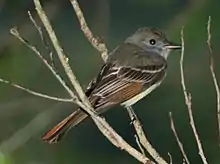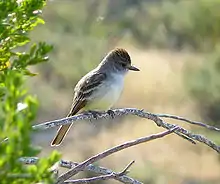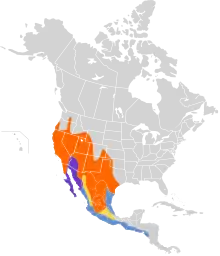Ash-throated flycatcher
The ash-throated flycatcher (Myiarchus cinerascens) is a passerine bird in the tyrant flycatcher family. It breeds in desert scrub, riparian forest, brushy pastures and open woodland from the western United States to central Mexico. It is a short-distance migrant, retreating from most of the U.S. and northern and central Mexico, spending the winter from southern Mexico to Honduras. This bird is also prone to wander, with single birds often seen outside its normal breeding range as far away as the east coast of North America.

| Ash-throated flycatcher | |
|---|---|
 | |
| In California, United States | |
| Scientific classification | |
| Kingdom: | Animalia |
| Phylum: | Chordata |
| Class: | Aves |
| Order: | Passeriformes |
| Family: | Tyrannidae |
| Genus: | Myiarchus |
| Species: | M. cinerascens |
| Binomial name | |
| Myiarchus cinerascens (Lawrence, 1851) | |
 | |
| Synonyms | |
|
Tyrannula cinerascens | |
The nest is built in a tree cavity or similar natural or man-made hole, and the normal clutch is three or four eggs.
Adult ash-throated flycatchers are 7.5 to 8.5 in (19 to 22 cm) in length and weigh 0.7 to 1.3 oz (20 to 37 g) The upperparts are olive brown, with a darker head and short crest. The breast is gray and the belly is a very pale yellow. The brown tail feathers and wings have rufous outer webs, and there are two dull wing bars. The sexes are similar.
The ash-throated flycatcher is separated from other confusingly similar Myiarchus species by its calls, a burry kabrick and a rough prrt or wheer heard year-round.[2]
This species is primarily an insectivore that flies from a perch to catch prey from the ground or from foliage in the undergrowth, less often from branches and trunks, hardly ever in midair. Unlike many other tyrant flycatchers, it often moves on to another perch rather than returning to the same one. It also takes some fruit, especially in winter if insects are unavailable. Rarely, it takes small mammals and reptiles, which it kills by banging them against hard objects.[2]
Taxonomy
First described in 1851 by George Newbold Lawrence from a specimen collected in western Texas in the United States, the ash-throated flycatcher was initially given the scientific name Tyrannula cinerascens.[3] The species was mistakenly described again in 1851 as Tyrannula mexicanus — an error that was corrected in 1859 when Philip Lutley Sclater analyzed the tyrant flycatchers known from Mexico and realized that both scientific names referred to the same species.[4] During the same analysis, Slater moved the ash-throated flycatcher from the genus Tyrannula to its current genus, Myiarchus.[5] In the past, the ash-throated flycatcher has sometimes been considered to be conspecific with Nutting's flycatcher, but there are morphological and vocal differences between the two.[3] There is disagreement as to whether the two species hybridize.[6]
The ash-throated flycatcher has two recognized subspecies:
- M. c. cinerascens, the nominate subspecies described by Lawrence in 1851, breeds from the western US down into southern and central Mexico and winters from the southern US to Honduras, principally on the Pacific slope.[3]
- M. c. pertinax, described by Spencer Fullerton Baird in 1860, is restricted to Mexico's Baja California.[3]
The genus name Myiarchus is a compound word created from the Greek words muia (μυια), meaning "fly" and arkos (αρχος) meaning "ruler" or "chief".[7] The species epithet cinerascens is a Latin word meaning "ashen".[7]
Description
The ash-throated flycatcher is a medium-sized tyrant flycatcher, measuring 7.5 to 8.6 in (19 to 22 cm) in length with a wingspan of 11.8 to 12.6 in (30 to 32 cm) and a mass of 0.7 to 1.3 oz (20 to 37 g).[8][9] Overall, it is slim and long-tailed, with a slightly peaked crest on its relatively large head.[8]
Conservation and threats
Because of its extensive range, very large population, and generally increasing numbers, the ash-throated flycatcher has been listed as a species of least concern by the International Union for the Conservation of Nature.[1] It is one of the species protected by the Migratory Bird Treaty Act.[10] In the United States, the creation of bluebird trails, a network of nest boxes put out for the continent's three bluebird species, may benefit ash-throated flycatchers as they will also use the boxes.[11]
References
- BirdLife International (2016). "Myiarchus cinerascens". IUCN Red List of Threatened Species. 2016. Retrieved 27 May 2018.CS1 maint: ref=harv (link)
- Cardiff, Steven W.; Dittmann, Donna L. (2002). Poole, A. (ed.). "Ash-throated Flycatcher (Myiarchus cinerascens)". The Birds of North America Online. Ithaca: Cornell Lab of Ornithology. Retrieved 30 March 2009.
- "Ash-throated Flycatcher (Myiarchus cinerascens)". hbw.com. Handbook of Birds of the World. Retrieved 27 May 2018.
- Coues, Elliott (Jan 1872). "Studies of the Tyrannidæ.: Part I. Revision of the Species of Myiarchus". Proceedings of the Academy of Natural Sciences of Philadelphia. 24 (1): 56–81.
- Slater, Philip Lutley (Oct 1859). "A List of the Tyrant‐birds of Mexico, with descriptions of some new species". Ibis. 1 (4): 436–445. doi:10.1111/j.1474-919X.1859.tb06224.x.
- McCarthy, Eugene M. (2006). Handbook of Avian Hybrids of the World. Oxford UK: Oxford University Press. p. 201. ISBN 978-0-19-518323-8.
- Jobling, James A. (2010). Helm Dictionary of Scientific Bird Names. London, UK: Christopher Helm. pp. 107, 263. ISBN 978-1-4081-2501-4.
- "Ash-throated Flycatcher: Identification". All About Birds. Cornell Lab of Ornithology. Retrieved 27 May 2018.
- "Ash-throated Flycatcher". National Geographic. Retrieved 27 May 2018.
- "Migratory Bird Treaty Act Protected Species (10.13 List)". U.S. Fish & Wildlife Service. Retrieved 27 May 2018.
- "Audubon Field Guide: Ash-throated Flycatcher". National Audubon Society. Retrieved 27 May 2018.
- Brooks, Derl Len & Strandtmann, R. W. (Aug 1960). "The Nasal Mites (Acarina) of Some West Texas Flycatchers (Tyrannidae)". The Journal of Parasitology. 46 (4): 418–432. doi:10.2307/3275132. JSTOR 3275132.
- Hendricks, Sarah A.; Flannery, Maureen E.; Spicer, Greg S. (Oct 2013). "Cophylogeny of Quill Mites from the Genus Syringophilopsis (Acari: Syringophilidae) and Their North American Passerine Hosts". The Journal of Parasitology. 99 (5): 827–834. doi:10.1645/ge-2400.1. JSTOR 41982101. PMID 23638969. S2CID 21772145.
External links
| Wikimedia Commons has media related to Myiarchus cinerascens. |
| Wikispecies has information related to Myiarchus cinerascens. |
- BirdLife species factsheet for Myiarchus cinerascens
- "Ash-throated flycatcher media". Internet Bird Collection.
- Ash-throated flycatcher photo gallery at VIREO (Drexel University)
- Interactive range map of Myiarchus cinerascens at IUCN Red List maps
- Ash-throated flycatcher Species Account – Cornell Lab of Ornithology
- Audio recordings of Ash-throated flycatcher on Xeno-canto.
